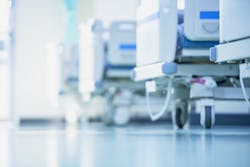5 Ways to Use Technology to Improve Patient Safety
All healthcare facilities aim to provide an optimal patient experience. Many patient safety technologies are available and used within the medical industry.
The way technology is implemented in healthcare facilities varies widely. In this article, we look at five ways your healthcare facility can use technology to improve patient safety.
1. Hand Hygiene Practices
Even before COVID-19 became a worldwide issue, hand hygiene was important. With the current pandemic situation worldwide, hand hygiene practices are an absolute must. Healthcare facilities are often more prone to the spreading of infections.
Using alcohol-based hand rubs or soap and water is one of the most effective strategies. Yet, it is critical to understand your facility's daily workflow. This allows you to identify areas posing a higher risk of infection spreading.
From there on, place dispensers or sinks at a comfortable height and which are visible. Bonus points if you opt for touchless fixtures and dispensers. You could also place signs or scents in your facility as a hand hygiene reminder for staff and patients.
Key takeaway: Touchless technology can considerably lower the risk of spreading infections. Use visual or sensory cues to encourage best hand hygiene practice.
[Related: How This Innovative Medical and Wellness Center Helps Florida Residents Take Control of Their Health]
2. Smart Infection Control
Using technology can help you reduce healthcare-associated infections (HAIs) within your facility. This is especially useful in the midst of COVID-19. Each year, one in 25 U.S. hospital patients contract at least one infection related to hospital care alone.
Patient care spaces should be properly designed for effective cleaning and disinfection. Go for easy-to-clean materials for surfaces and equipment, especially in areas often crowded. Also, consider surgical tracking solutions to ensure proper maintenance of instruments. Biological indicators help you identify unclean equipment.
Furthermore, touchless clock-in for your workforce can prove a game-changer for infection control. This allows your staff to check in and check out through voice and face recognition. Finally, avoid hard-to-reach corners or crevices in patient care areas.
Key takeaway: Healthcare-associated infections are very common in healthcare facilities. Proper facility design and adequate technology can help control and limit the transmission of HAIs.
3. Automating Routine Tasks
You can boost your healthcare facility's routine safety protocols with the right technology. You can find different systems on the market that increase patient safety processes. A plethora of options currently exist on the market, so you can choose according to your needs.
For instance, routine processes, such as nurse calls, can be automated. Many systems allow you to configure reminders for the assigned caregivers. With the current pandemic, automated systems can be very helpful. Caregivers receiving notifications of their tasks reduces the need to interact with shared printed schedules.
This may considerably reduce the risks of spreading an infection since caregivers are less prone to handling common planners. Additionally, automation of routine tasks ensures your staff is always on track with their workflow and can even increase productivity.
Key takeaway: Most routine tasks within your healthcare facility can be automated with the right technology. Consider automating tasks that require users to excessively interact with each other.
[Related: Black-and-White Theme Creates a Deluxe Dental Office in Virginia]
4. Adequate Environmental Barriers
As mentioned above, patients are more prone to infections in a healthcare setting. This is likely due to the prior occupant of the room spreading the pathogen. A study reports that patients are 2.69 times more likely to contract a healthcare-associated infection (HAI) when hospitalized in double-occupancy rooms.
In a healthcare facility, environmental barriers can block out and eliminate HAIs and help prevent vulnerable patients from contracting them. Every year, 1 to 3 million serious HAIs lead to 380,000 deaths.
Smart ventilation systems are effective at reducing the transmission of healthcare-associated infections. High-efficiency particulate air (HEPA) filtration removes airborne pathogens. The Centers for Disease Control and Prevention (CDC) and the Joint Commission recommend HEPA filtration in patient care areas.
Key takeaway: Patients may spread infectious pathogens during their visit or stay. Setup proper environmental barriers to limit and eliminate the spreading of HAIs.
5. Fall Prevention for Patients
Preventing at-risk patients from accidental falls is essential. According to the AHRQ, 700,000 to 1 million patients suffer a fall in a U.S. hospital each year. Out of this, 30 to 50% of individuals need medical help.
Your healthcare facility's design is a critical component in preventing patient falls. For instance, a study shows that the distance and location of the bathroom in a patient’s room impact the number of patient falls. Consider grab bars and handrails in patient areas to assist them in moving from one point to another.
If altering your facility’s design is not an option, using telesitting for fall prevention can be helpful. For instance, Ochsner Health reduced falls by 51% with telesitting solutions. In-room cameras send alerts to designated caregivers every time the monitored patient is at risk.
Key takeaway: Patient falls in healthcare facilities can be prevented. You can either alter your facility’s design for enhanced safety or go for telesitting.
Off You Go
Over the years, advancements in technology have been reshaping the healthcare sector. The focus has always been on developing efficient healthcare technology. Yet, it is the responsibility of the healthcare organization to provide a safe environment for patients.
Most infections and accidents within a healthcare facility can be avoided. Properly pairing facility design and technology can greatly improve patient safety by adding an additional layer to the quality of care, which in turn, can enhance your facility’s reputation.
About the Author:
Derek Jones is the Vice President of Enterprise Strategy of Americas for Deputy, a global workforce management platform for employee scheduling, timesheets and communication.
Read next: Can Greener Hospitals Save People and the Planet?
About the Author

Contributed Author
BUILDINGS partners with industry experts to bring you contributed content covering the hot topics for building owners and facility professionals.
